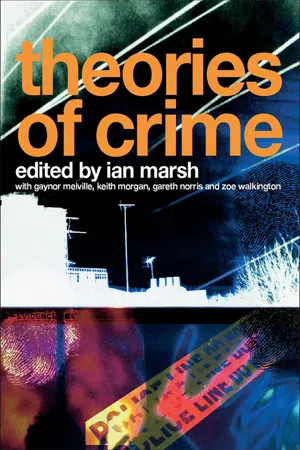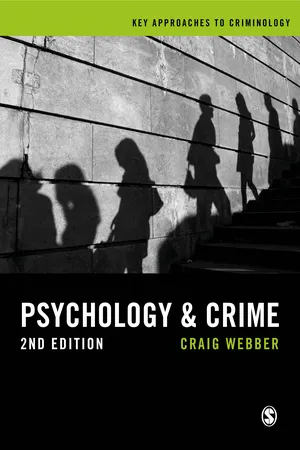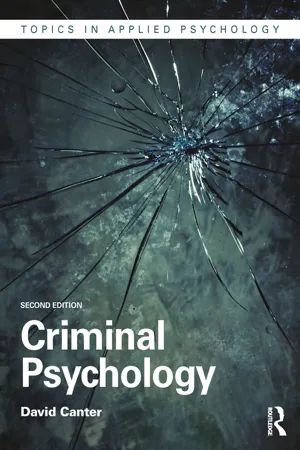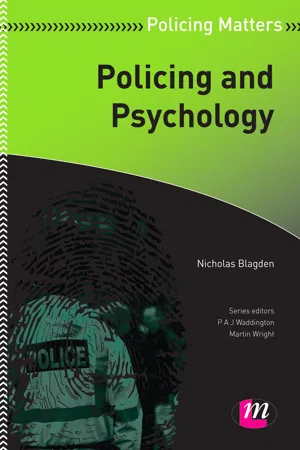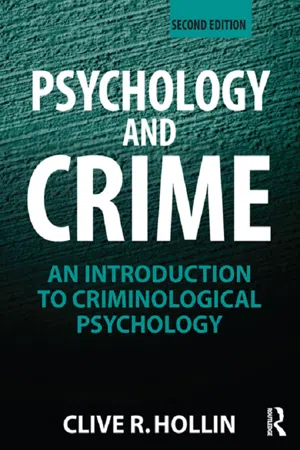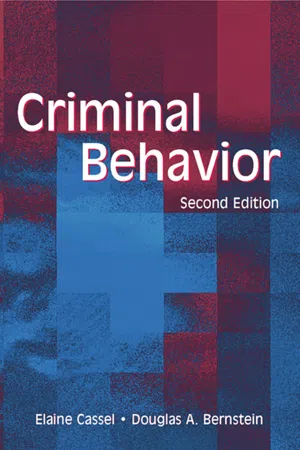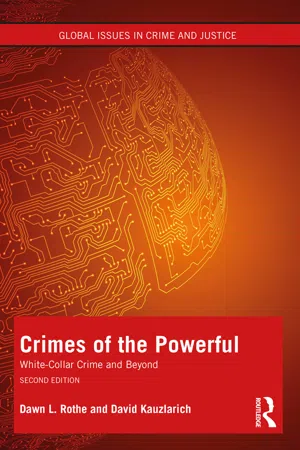Psychology
Types of crime
Types of crime refer to the various categories of criminal activities, such as violent crimes (e.g., assault, murder), property crimes (e.g., theft, burglary), white-collar crimes (e.g., fraud, embezzlement), and cybercrimes (e.g., hacking, identity theft). Understanding these types of crime is important in the field of psychology as it helps in studying the causes, motivations, and impacts of criminal behavior on individuals and society.
Written by Perlego with AI-assistance
Related key terms
10 Key excerpts on "Types of crime"
- eBook - ePub
- Ian Marsh, Ian Marsh(Authors)
- 2007(Publication Date)
- Routledge(Publisher)
CHAPTER 3Psychological Explanations for Criminal Behaviour
INTRODUCTION
For many centuries, we have attempted to find out which people are likely to become criminals and what drives certain individuals to commit a particular type of crime in the first place. Over the years psychologists have considered a range of different explanations in order to answer these difficult questions. Some have argued that there may be a genetic explanation which is at the centre of explaining criminal behaviour; others have suggested that it is the environment in which people live which can influence their chance of becoming criminal.At different periods in history these ideas have been prominent in the minds of not only psychologists but also other professionals and the public alike. However nobody has seemingly provided a comprehensive and infallible answer to the question of criminality. This chapter will introduce some of the key theories that psychologists have attempted to use to explain criminal behaviour, such as personality, social factors and cognition.CRIMINALITY AS AN ELEMENT OF PERSONALITY
It is common for us to attach labels to criminals and attempt to explain their behaviour through describing them as possessing a certain character trait. For example, it is common to refer to some criminals as ‘psychos’—particularly in films and the newspapers. This type of person is actually called a psychopath and labels such as these have been developed by psychologists to help us understand the different types of personality category that people fit into. Not all of these are criminal, but it is assumed that many criminals possess similar personality characteristics. Clearly there are some important factors to criminality that can be explained by situational and developmental factors, but there is also the psychological element to criminal activity that is relatively unique to that individual. One possible explanation for this desire to uncover the psychological traits of offenders is that it provides a quantifiable difference between ‘us’ and ‘them’ and to some extent further defines law-breakers as being almost another ‘breed’ of person. The following section will describe the different explanations of criminal personality - eBook - ePub
- Helen Gavin(Author)
- 2018(Publication Date)
- SAGE Publications Ltd(Publisher)
3 Psychological Approaches to Understanding CrimeKey Themes
- Biosocial theories of crime
- Social learning theory and crime
- Psychodynamic theories of crime
- Evolutionary models of crime
- Feminist models of crime
In many sciences, there are attempts being made to find a unified theory, so far, unsuccessfully. Even in a discipline such as physics, the concept of a unified theory has a seemingly insurmountable barrier to overcome in that two compellingly explanatory theories (general relativity and quantum theory) are totally incompatible. So, it is hardly surprising that the study of mind and behaviour is no exception to such a quest, or such difficulties. The study of crime is no stranger to this desire to discover a global explanation, but we remain with the position of several different perspectives attempting to provide understanding of criminal behaviour within existing psychological frameworks. Psychological explanations of crime suggest that individual differences may make it more likely that some people commit crimes than others. These differences may be due to personality characteristics, biological factors, or social influences. There is therefore a hierarchical set of different perspectives, from the social to the individual, that are useful in understanding the nature of crime and the theories attempting to explain it.Strain theory – social structures exert pressures which may lead an individual to commit crime.Crime and the Role of Society
Social theories suggest that crime is an outcome of the breakdown in social structures. This can be either at a structural level, where societal processes affect members of society, or at an individual level, where the experiences of people as they seek ways to satisfy their needs are examined. The first major theorist in this area was Merton, whose 1938 analysis of the relationship between society and the values and behaviour of members of that society was pivotal in the sociological examination of crime. The resultant theoretical perspective, strain theory, is an attempt to explain crime via the pressures that society and societal goals can exert. Hence, unemployment, inequity, abuse of power, and other macro-level issues are direct influences on crime and the causes of crime. Violence may occur as a result of harassment, stealing may be to resolve financial problems. Agnew (1992, 2009) updated the theory to account for different types of strain, such as that resulting from society preventing the achievement of goals, and the strain occurring when in receipt of negative or noxious stimuli, such as the theft of valued items, or anger against the individual. Agnew termed this a general strain theory, attempting to describe the ways in which strain impacts in society and particularly on young people. He suggested several characteristics of strain that might lead to crime, that it is: - eBook - ePub
Psychology and Crime
A Transdisciplinary Perspective
- Craig Webber(Author)
- 2019(Publication Date)
- SAGE Publications Ltd(Publisher)
2 Psychological Perspectives on Crime Overview Moving on from a historical overview of social scientific understanding of crime, this chapter looks at the different psychological perspectives that constitute psychology. We will see that although they are sometimes presented as discrete areas of research, in fact there is some significant overlap between them. If we want to understand the problem of many accounts of crime, both sociological and psychological, then we can interrogate them through the lens of age. One of the key criminological truisms is that most people grow out of crime (Rutherford 1986/2002). This will be a recurring theme of this chapter so that the different psychological perspectives can be understood through issues like aging and desistance from crime. Key terms ■ Psychological Perspectives; Biological Psychology; Behaviourism; Cognitive Psychology; Psychoanalysis; Social Psychology The previous chapter explored the main approaches to understanding crime as they developed historically; this next chapter is a more in-depth overview of some of the major psychological approaches to studying human behaviour. This is not meant to be an exhaustive overview, merely a reminder for those who have already studied psychology, and an introduction for those who have not. All psychological approaches share the common focus of studying internal mental processes. Psychology can be distinguished from psychiatry through the latter’s focus on the study and treatment of mental illness and emotional disturbance. Psychiatry is a branch of medicine that, for the most part, focusses on illness and derivations from ‘normal’ 1 behaviour. Psychology is interested in a broader range of human behaviour that includes mental functions such as perception (e.g. taste, colour or object sizes), the capacity and ability of memory, as well as behaviour that some might describe as ‘abnormal’ such as aggression - eBook - ePub
- David Canter(Author)
- 2017(Publication Date)
- Routledge(Publisher)
2 Psychological differences between crimesPassage contains an image
5 Acquisitive crimeLEARNING OBJECTIVES
When you have completed this chapter, you should:1 Appreciate the factors that contribute to a burglar’s decision to offend.2 Comprehend the classifications of burglars and the utility and limitations of classification models.3 Understand the ways in which burglars can be differentiated.4 Appreciate the various types of corporate crime and fraud.5 Understand the various psychological theories relating to acquisitive crimes.SUMMARY
There are two broad offence categories that have somewhat different psychological features. One covers all those crimes that are focused on the acquisition of property. These include burglary, theft and various forms of fraud. They are dealt with in the present chapter. The second broad category includes all those crimes directed at people, which includes violent and sexual offences, as well as homicide. There is much more extensive study of the psychological issues in crimes against the person, so, although property crime is the most common – often referred to by law enforcement agencies as ‘volume crime’, there are more chapters in this book dealing with violent crimes.Crimes that focus on getting someone else’s property do take many different forms. Breaking into a house and stealing something is, perhaps, the most ‘traditional’ of these, but many types of frauds also need to be considered. These are growing rapidly as it becomes possible to fraudulently steal in virtual reality, rather than on the street. The psychological variations in these crimes relate to the characteristics of the offenders, their skills and attitudes as considered in previous chapters.DEFINING ACQUISITIVE CRIME
Taking anything that belongs to someone else is classed as acquisitive or property crime. In most legal systems, a distinction is made between taking something without violence or the threat of it, such as burglary or shop lifting and robbery, or mugging, where violence or intimidation are part of the crime. In reality, this legal distinction is often difficult to make, so there are crimes called aggravated burglary. How should blackmail and extortion be classified when there are implicit threats for financial gain? Various forms of fraud and crimes, such as tax evasion and kidnapping, are generally considered property crimes as well. There is also a range of property crimes that do not involve direct financial benefits, where there is a transfer or destruction of prop erty. These vary from petty vandalism to major arson. But, because property is the target, they are considered in the present chapter. The distinguishing psychological feature is that the target of the crime is not a person, as such, but something physical. - eBook - ePub
Understanding Crime
A Multidisciplinary Approach
- Susan Guarino-Ghezzi, A. Javier Trevino(Authors)
- 2014(Publication Date)
- Routledge(Publisher)
Behaviors of the third type, also known as instrumental-cognitive crimes, have a highly cognitive emphasis to them. Most commonly in homicide, we see Type I crime scenes in which the offender has lost control and acted impulsively, without thinking. In Type 3 cases, however, the offender remains calm during and after the crime, and engages in behaviors that suggest a great deal of advance planning, such as removing forensic evidence from the crime scene, transporting the body away from the original crime scene, and disposing of the body by hiding or burying it. These activities suggest that offenders are actively distancing themselves from the victim and the crime, and by so doing, distancing themselves as the suspect. Many of these offenders are aware of forensic evidence (e.g., the weapon, blood, semen, etc.), which they make sure not to leave behind.This case gives an extreme example of this type of crime, an example in which the offender has engaged in activities over and beyond the norm of just hiding the body. In this case, the offender has gone as far as trying to cut the body of the victim into several pieces for easy disposal, but failed.The offenders associated with Type 3 homicides, which have a cognitive focus, choose aggression and violence as a lifestyle. Some of these offenders are also likely to have committed prior violent offenses.Results from recent empirical studies on the behavior and psychological characteristics of killers, such as the study summarized above, have established a classification system of homicide crime scenes and its related offenders, one that goes beyond the personal and anecdotal experience of any one profiler. This demonstrates that by using our understanding of human behavior, derived from general psychology, for differentiating criminal behavior in a way that is relevant to police investigations, it is possible to establish the foundations for a repeatable scientific approach. By so doing, we can begin to demystify the previously obscured process of psychological profiling and establish what can be expected from profiling and what needs to be done in order to make it a more valid and reliable investigative tool.Summary
Psychology, as we have described, is a complex discipline, which encompasses a wide spectrum of theoretical approaches. In this chapter, we have by no means been exhaustive in our overview of the discipline, but instead have attempted to give a summary of some of the main psychological theories as they relate to criminal behavior. In order to situate the work of a forensic psychologist, we provided some general background on the discipline of psychology. We highlighted the notion that psychology is the scientific study of behavior, but that psychologists are also interested in understanding underlying mental constructs—such as personality, cognition, emotion—and how these are manifested in behavior. We discussed the various orientations of psychologists (biological, cognitive, social, clinical, and forensic) and the interests and major focus of each. We then closely considered the forensic psychologist, the type of psychologist most involved in the criminal justice system and most interested in criminal behavior. - eBook - ePub
- Nicholas Blagden(Author)
- 2012(Publication Date)
- Learning Matters(Publisher)
2Psychological theories of crime and criminal behaviour
CHAPTER OBJECTIVES
By the end of this chapter you should be able to:- understand some of the main psychological theories of crime and criminal behaviour;
- apply these theories to case studies and real-world policing examples;
- think critically about psychological theories of crime and their application to criminal behaviour.
LINKS TO STANDARDSThis chapter provides opportunities for links with the following Skills for Justice, National Occupational Standards (NOS) for Policing and Law Enforcement 2008.AE1 Maintain and develop your knowledge, skills and competence. HA2 Manage your own resources and professional development. HF15 Provide information to support decision making. With the introduction of the Qualification and Credit Framework (QCF), it is likely that the term ‘National Occupational Standards’ will change. At the time of writing, it is not clear what the new title will be, although it is known that some organisations will use the term ‘QCF assessment units’.Links to current NOS are provided at the start of each chapter; however, it should be noted that these are currently subject to review and it is recommended that you visit the Skills for Justice website to check the currency of all the NOS provided: www.skillsforjustice-nosfinder.com .Introduction
Why people commit crime is something that academics and practitioners have tried to explain for many years. This chapter explores some of the main psychological theories that can help explain and predict why some people commit crime and others do not. The chapter aims to provide an in-depth summary of some of the key theories, including psycho-biological, social and cognitive-behavioural approaches. Through an understanding of these theories students, particularly those pursuing careers within law enforcement agencies, will gain an insight into the many factors that influence criminal behaviour. An understanding of these theories will broaden students’ and trainee police officers’ perceptions on what (if anything concrete) causes offending behaviour. - eBook - ePub
Crime and Criminality
A multidisciplinary approach
- Sandie Taylor(Author)
- 2015(Publication Date)
- Routledge(Publisher)
Part III Different Types of crime and criminal with a focus on nature, nurture and nature–nurture Chapter 6 White-collar criminals and their crimes The aim of the chapters in Section 3 is to present evidence for a nature–nurture contribution towards a selection of criminals: in this case the white-collar criminal. As with all chapters in this section, a multidisciplinary approach will be taken such that evidence is drawn from a variety of academic subjects which address crime and the criminal. Later in the concluding chapter, the evidence will be evaluated. We begin this chapter by disambiguating the definition of the white-collar criminal introduced by Sutherland. Although he claimed that white-collar criminals are respectable people with a high social status, criminologists prefer to perceive them as individuals who commit occupationally related crime. In other words, white-collar criminals commit crimes related to the workplace as a means of attaining money through deceit. This covers a range of work-related misdemeanours leading to monetary gains. By using this definition of the white-collar criminal it is possible to include many different forms of white-collar crime. As we shall see in this chapter, white-collar crime varies immensely from less serious to serious, and from operating on a small-scale to a large-scale. We explore some famous UK and US examples of large-scale serious white-collar crime. UK examples include the Guinness Affair and Robert Maxwell, and the US example is John Grambling Jr. A link between psychopaths and white-collar criminals was made by Robert Hare, claiming that they share a set of personality traits, in particular little warmth and empathy towards their victims. Differences between white-collar criminals and other criminals will be examined in terms of how they commit their crimes and other distinguishing features - eBook - ePub
Psychology and Crime
An Introduction to Criminological Psychology
- Clive R. Hollin(Author)
- 2013(Publication Date)
- Routledge(Publisher)
causes – biological, or psychological, or social, or a mixture of all three – of criminal behaviour. Research with a focus on causal relationships is often allied to scientific philosophies and methodologies that aim to control, measure, and determine relationships between sets of variables. The aim of such scientific research is to produce empirical findings that are reliable, verifiable, and replicable. This approach to research is characteristic of a positivism, a style of social research with a long history (Halfpenny, 1982/1992). It has become fashionable in some quarters to disparage positivism (Smith, 2004) although, as Halfpenny (1982/1992: 11) states: ‘There are differences among anti-positivists, who use the term loosely and indiscriminately to describe all sorts of disfavoured forms of inquiry’.Another criticism of psychological research applied to criminal behaviour, stretching back to Lombroso and Freud, is that there is an undue stress on defects, deficits, and developmental delays. Thus, rather than Durkheim’s normality of crime, psychological theories stress the ways in which the offender is different to the normal, non-criminal population. This emphasis had an effect on the way a psychological perspective was appraised by some criminologists: ‘Psychological theories are useful as explanations of the behavior of deeply disturbed, impulsive, or destructive people. However, they are limited as general explanations of criminality. For one thing, the phenomenon of crime and delinquency is so widespread that to claim that all criminals are psychologically disturbed is to make that claim against the vast majority of people’ (Siegal, 1986:175–6). Siegal’s point regarding psychological disturbance and criminal behaviour is further discussed in Chapter 8 .The approach to explaining criminal behaviour as seen so far is one of applying a theory to criminal behaviour then setting about the task of research. However, a different approach is to use empirical research to formulate an understanding of criminal behaviour. The longitudinal research investigating the development of anti-social and criminal behaviour, has added significantly to our appreciation of the aetiological complexity of these forms of behaviour. The longitudinal research, including the work of David Farrington and Terrie Moffitt, is discussed in the following chapter. - eBook - ePub
- Elaine Cassel, Douglas A. Bernstein(Authors)
- 2007(Publication Date)
- Psychology Press(Publisher)
5 Psychological Roots of CrimePersonality and Crime Learning and Crime Traits and Crime Cognition and Crime Psychodynamics and Crime Personality Disorders and Crime I n chapter 4 , we considered biological roots of crime, including the influence of genetic inheritance, the brain and central nervous system, and hormonal and other physiological mechanisms that influence aggression and violence. In this chapter, we introduce the psychological theories that attribute the roots of crime to mental processes that develop as people interact with their families and others. We focus on the major psychological theories of personality and personality development as well as on theories about how people process information, think, learn, and interact with others. We then apply these concepts as we trace the development of crime and mental disorders in chapters 7 , 8 , and 9 .Personality and Crime
We begin by looking at psychologists’ efforts to develop theories about what personality is, how it can best be measured, how it develops, and how it might be changed.In describing someone’s personality, people usually employ adjectives such as “friendly,” “kind,” “warm,” or perhaps “difficult,” “hostile” or “insecure.” In doing so, one is trying to summarize the essence of that person’s behavior and attitudes, the characteristics that describe a particular individual. Most psychologists agree that personality consists of the unique patterns of thinking, feeling, and behaving that are relatively constant throughout one’s life and through which one can be compared and contrasted with other people.Where does personality come from? It begins with the biological predisposition to act and respond to the world in particular ways, which psychologists call temperament - eBook - ePub
Crimes of the Powerful
White-Collar Crime and Beyond
- Dawn Rothe, David Kauzlarich(Authors)
- 2022(Publication Date)
- Routledge(Publisher)
Chapter 3 Theoretical Understandings of Crimes of the PowerfulDOI: 10.4324/9781003124603-3We should state at the onset that our approach here is not like most textbooks on white-collar crime that introduce you to a host of criminological theories you read small snippets of and attempt to apply (e.g., biosocial theories, psychological theories, social control, rational choice, low self-control models, or even social bond models). Although many traditional criminological theories contribute to some understanding of juvenile delinquency, robbery, burglary, and other conventional domestic criminal activities, as individual theories, they have serious shortcomings and are only able to explain a small portion of variance (Agnew 2012; Kauzlarich and Barlow 2009). This has resulted in limited understanding and a general over-focus on individuality and subsequent individual “blame.” Of course, personality, socialization, and upbringing do matter to a small degree. We have all most likely met a narcissistic, self-aggrandizing, or hedonistic person. Yet, many of these theoretical perspectives result in simplistic interpretations where motivations are reduced to “greed,” “psychopathic traits,” or socialization. Additionally, many of these theories need a well-rounded base of personal individual facts, from life background to mental health conditions, that are generally unavailable to researchers and/or omitted from any analysis.Instead, we aim to take a much broader approach given that our underlying assumption is that crimes of the powerful are not parsimonious events, acontextual or ahistorical, but are complex phenomena that must account for a broad array of conditions including individual agency. Humans and the human mind are complex, and individuals do not operate in a vacuum. This is especially true for the powerful criminal, whose actions, motivations, and responses are situated within a system that fosters and facilitates their crimes and should not be ignored or discounted.
Learn about this page
Index pages curate the most relevant extracts from our library of academic textbooks. They’ve been created using an in-house natural language model (NLM), each adding context and meaning to key research topics.
